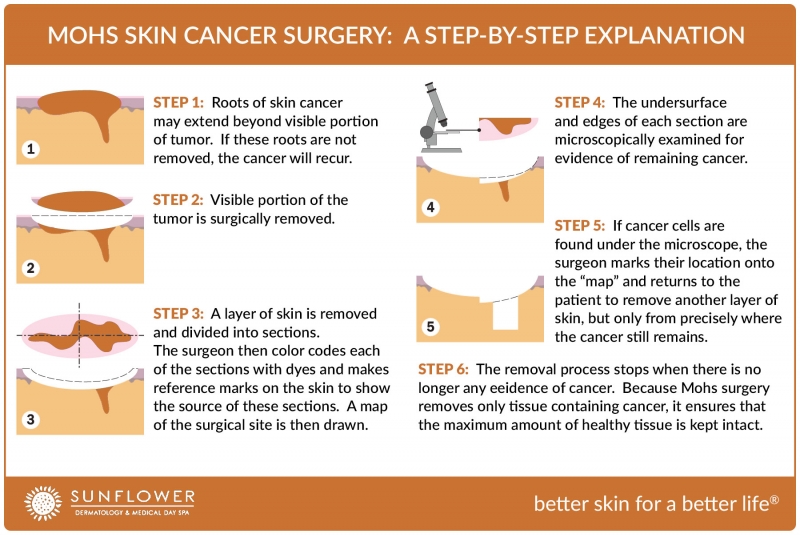What is Mohs Surgery
and why is it the best option for skin cancer removal?
and why is it the best option for skin cancer removal?
Mohs Surgery, also known as Mohs Micrographic Surgery (MMS), is the most effective surgical procedure to remove Basal Cell Carcinomas (BCC’s) and Squamous Cell Carcinomas (SCC’s), 2 of the most common types of skin cancer. The Mohs Surgery option provides the highest cure rate for skin cancers.
Kansas City’s Sunflower Dermatology & Medical Day Spa is a leader in providing complete, comprehensive, and compassionate care in the treatment and cure of basal cell and squamous cell carcinoma skin cancers. Sunflower Dermatology’s Board Certified Physicians, Surgeon and Pathologist Brian Matthys, DO and Nicholas Rudloff, DO perform Mohs Surgery at Sunflower Dermatology’s Riverside, MO clinic. Coming soon, we will be performing the procedure in St. Joseph, MO. The entire procedure and pathology is conducted in-clinic, in one visit. Patients can be assured that their skin cancer has been completely removed during the first procedure. Mohs Surgery eliminates the need for invasive multiple surgeries that only prolong patient anxiety and recovery.
The History of Mohs Surgery
Mohs surgery was developed by Dr. Frederic E. Mohs in the late 1930’s. In the early years, Mohs surgery was known as “Chemosurgery”. Dr. Mohs utilized a paste made with zinc chloride that was applied to the skin and covered with a surgical bandage until complete penetration of the affected cells was obtained. This would keep the skin cells intact when removed during the procedure and viewed under a microscope. The process was tedious, and in some instances, would take days to complete. Only the area of skin that had absorbed the zinc chloride cream could be tested for the presence of skin cancer cells.
In 1953, Dr. Mohs was preparing to remove cancerous cells from a patient’s eyelid, and was extremely apprehensive about using the zinc chloride so close to the patient’s eye. So instead, Dr. Mohs opted to use a local anesthesia to numb the site and began with conservatively excising a tissue sample from the cancerous area. He then “instantly” viewed the tissue under the microscope to determine whether the edges were clean and free of cancer, if they weren’t he was able to immediately remove additional tissue and continue instantly evaluating the edges until it was determined that he had completely removed the patient’s skin cancer. The realization that there was no need to make patients wait for the results of zinc chloride procedures or to require multiple procedures and prolonged heal time was ground breaking for Dr. Mohs and the medical industry. This new technique was eventually named Mohs Micrographic Surgery (MMS).

What can I expect when I Arrive
at Sunflower Dermatology for My Mohs Surgery?
at Sunflower Dermatology for My Mohs Surgery?
Upon arrival, Dr. Brian Matthys or Dr. Nicholas Rudloff will mark where the Basal Cell and or Squamous Cell Carcinomas are located, and administer a local anesthesia (lidocaine) to numb the surgical area. Local anesthesia reduces the risk of complications from general anesthesia, and this allows for the procedure to be done in the doctor’s office instead of a surgical center.
The procedure is performed in stages. The idea behind Mohs surgery is to keep as much healthy skin untouched by surgery. The first step is to remove the visible skin cancer/tumor. After the tumor removal, Dr. Matthys will continue to remove small slivers of tissue from the surrounding area and immediately screen the skin cells in Sunflower Dermatology’s in-office laboratory to confirm whether cancerous cells are still present. If they are, the process will be repeated until the entire skin cancer has been removed.
How long does Mohs Surgery Usually Take?
Before your surgery, Sunflower Dermatology will go over the procedure with you and give you an estimate for how long we believe your surgery will take. Most procedures go quickly but depending on the location and the size of your skin cancer, procedures can sometimes take up to 3 hours or longer.
Can I Take My Daily Medications with Mohs Surgery?
In most cases, people can take their daily medications prior to surgery. However, there are some medications, such as anticoagulants (blood thinners) that should not be taken if possible, patients should consult with their physicians on this.
When listing your medications, it is important to disclose all over-the-counter medications and supplements that you take on a regular basis. Some common supplements and over-the-counter medications have the potential to act as a blood thinner. These include:
- Aspirin
- Advil/Motrin (ibuprofen)
- Aleve (naproxen)
- Fish Oil
- Garlic
- Vitamin E
- Bromelain
Do I Need to Fast for Mohs Surgery?
Usually, fasting is not required, but again, confirm with your physician if fasting is required for your Mohs Surgery.
How long does it take to Recover from Mohs Surgery?
Healing time will vary depending the location, size and depth of the skin cancer. Most people are back to work the next day with some minor discomfort. It is important to follow all aftercare instructions that your doctor provides to you.
If you have any questions regarding Mohs Micrographic Surgery (MMS) or would like to schedule an initial visit with Dr. Brian Matthys or Dr. Nicholas Rudloff to discuss any skin cancer concerns, please contact us:
Schedule your Mohs Skin Cancer Surgery at Sunflower Dermatology – Kansas City
Our Riverside Location:
1805 NW Platte Rd., Suite 120
Riverside, MO 64150 | CLICK HERE for Directions
Phone: (816) 205-8120
SEND US AN E-MAIL
Our St. Joseph Location:
805 N 36th St., Suite D
St. Joseph, MO 64506 | CLICK HERE for Directions
Phone: (816) 205-8120
SEND US AN E-MAIL

